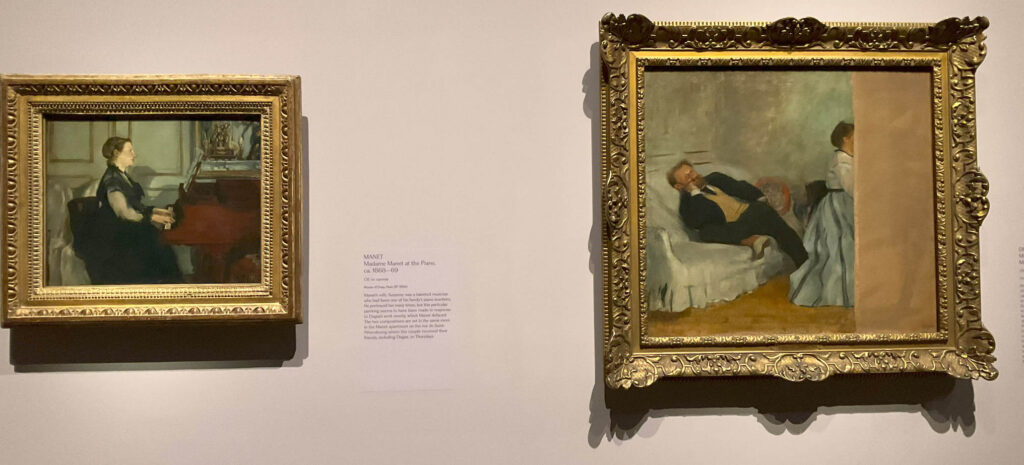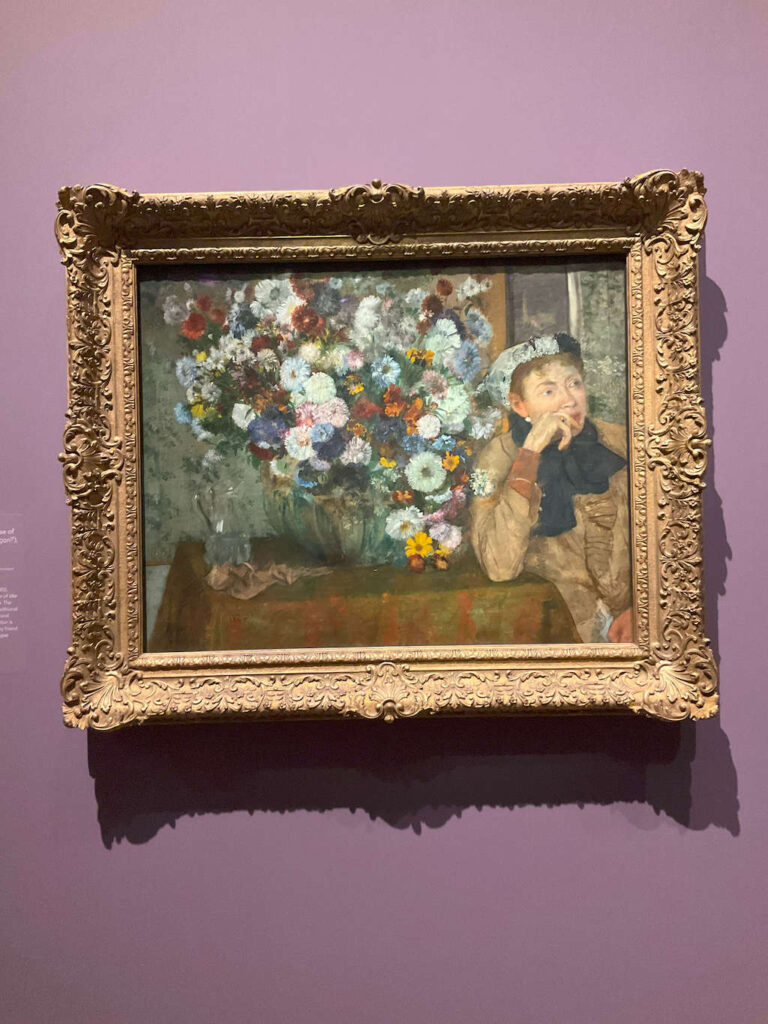Elizabeth Ashe


Manet/Degas, first exhibited at the Musee d’Orsay opens with a split slash in the wall and modestly sized self-portraits by the artists. When the exhibit was at the Musee d’ Orsay, it switched things slightly – the entrance images were two portraits of women, and later, the artists’ self-portraits were a room away with a cut-through that framed the view of “Olympia.”
The mood is set: rivals and friends, nearly the same, down to the pose, the beards, the faces, but one was French, one Italian, one older than the other, one trained at the Academy (Degas), one not. Both painted at the same places in Paris, and learned to paint by copying at the Musee du Louvre in the early 1860s. With both artists copying the portrait of the Infanta Margarita Teresa by Diego Velasquez, Manet was astounded at Degas’ method of painting without any preliminary sketching.
First, they were friends, remaining so through the 1860s, united by their mutual admiration of the Old Masters, especially those they saw exhibited at the Louvre. One, French (Manet), and one Italian, trying so hard to be French (Degas, whose surname was changed by his father from the Italian De Gas), they painted bathers, prostitutes, dancers, portraits, domestic scenes, and horse races. They wanted to show people they knew and admired, the seedy/gritty culture of Paris, cafes and barmaids, women at their toilette, combing their hair, the upper middle class devotion to horse racing and young dancers, prostitutes and wealthy ladies and men. The subject was similar, but the approach, brushwork and quality of line was often technically and stylistically different, with Manet ultimately rejecting inclusion with the impressionists. They spent a great deal of time together. The exhibition at the Met centers on their relationship, through the close years, and when warring with each other, bringing it to light in ways a typical survey class on Impressionism doesn’t.
In the Metropolitan Museum exhibit’s first room, their relationship is presented as George Moore said, as one “jarred by an inevitable rivalry.” Figure studies and drawings by Degas, a portrait of a lounging Manet on a couch and his wife, Suzanne at the piano in an intimate setting only a friend would see. It was a gift between artists. However, Manet sliced off the right side, right before his wife’s face began, because he didn’t like the way Degas depicted her features. Manet attached a strip of black painted canvas where the image of the face was, and blacked out the composition. Degas took the painting back, and returned to Manet a still-life painting Manet had given him. The rivalry, amid respect for each other as painters, was clearly tense. Degas never repaired the painting. Manet’s portrait of his wife playing the piano, is displayed next to the maimed painting. Suzanne was an accomplished pianist; in fact she was Manet’s piano teacher when they met, and he certainly admired her beauty, and did not believe that Degas had clearly depicted it. It would figure that Manet would want to be the only one to paint her and his painting, “Madame Manet at the Piano” does have a stronger composition and beautifully featured face than Degas’ initial painting.
They borrowed one another’s themes. Degas was known for his bathing women. Manet sketched and painted them too. They focused on expressive portraits, though Manet’s were more often about the Parisian in the alley. They both admired, studied and copied Titian, Mantegna, Velazquez and Delacroix, sometimes admiring and copying the same works. They depicted their own families and their families socialized together. Musicians and music lessons were themes in common, showing another art in private settings.

Olympia. My favorite painting is on a wall by herself. They / Degas / the Salon / Paris itself, dared Manet to do a nude. And so he did. In a real way that the public didn’t want; they wanted aTitian prostitute who couldn’t talk, not their sister. His nude also gave them known symbols for sex in French art – a black cat, albeit all hissy, the casual bedroom slippers, flower in her hair, bouquet and maid. The maid’s coral earrings hint at Olympia’s flower and mutual liminal status, and her pale pink dress with white frill is also sexy and keeps the color centralized on Olympia. Unwrap the bouquet, present it, remove your hand. What no one wanted was to be challenged right back. Olympia knows who she is, stares right back and doesn’t give a damn about the flowers. Like the defensive cat, she covers herself with an incredibly well-painted hand. The line of her body is real, and it’s Japanese linework — simply rendered strength and beauty. This painting is my favorite for all of these reasons – the challenge back by artist and woman, the Japanese influence before it was embraced, less is more. For the same 1865 Salon — where history paintings were still the high pinnacle to achieve — Degas entered “Scene of War in the Middle Ages”, an attempted and ignored history painting which is really quite bland, but hung on the second tier from the top, at the salon with other history paintings. After this failure, Degas stopped history paintings. How is it that Degas dared his friend, and then did something so safe and so ignored? Did he aim to cater to the establishment and highlight his friend, or cater to the establishment and disregard his friend? Immediately after, Degas painted “A Woman Seated beside a Vase of Flowers,” an off composition where flowers dominate and the woman is only barely there. Not portrait nor still life, but still a much better painting.


The year before “Olympia”, Manet had submitted “The Dead Christ with Angels” to the Salon exhibition, criticized for being a cadaver Christ with a drawing looseness (which Degas liked) and wrong side rib injury. It’s a little Goya-on-religion for me, but the looseness is a breath of fresh air to a tired religious theme. The exhibition continues with more portraits in interior settings; Manet’s full body depictions with strong outward gazes and personality, and Degas’s cropped, seated or reclining figures.
Their bather paintings are simple – sharing a close space with a woman depicted in strong gestural lines, with a looseness and mottled white background. The air feels quiet. The similarity is quite lovely and clean, for lack of a better term. Of the paintings of women in cafes, Manet’s “Plum Brandy” focuses on the woman, who looks thoughtful. I want to know what she is daydreaming about. In Degas’ composition for “In a Café (the Absinthe Drinker),” the woman looks too introspective – it’s almost boredom or depression, and a man is seated next to her looking out into the room. As cafe scenes replaced domestic settings, changes in culture and nightlife were highlighted by both painters.
Ten years later, Degas painted Manet’s younger brother in a field, with a walking stick. The pose and stick nod to an earlier Manet painting of his brother. It’s nice to think about how they considered each other’s work across so many fronts and over the span of decades, as they continued to gift works to one another. Manet and Degas took on horse races as a theme and popular pastime. Degas depicted the races before they started but used published aids for his composition in “At the Races”; Manet as the horses ran in “the Races in the Bois de Boulogne.” An outdoor public event, there’s a great deal of activity in the background but they aren’t nearly as memorable as their portraits.
The American Civil War put their political differences to the forefront. Degas’ family connections to the South, having lived in New Orleans, kept to images as those in “Cotton Merchants in New Orleans.” Airy and very Fibonacci in its composition,the painting included part of a ship painting as a nod to his brother’s merchant company. At this time, using the same venue, the American South, Manet instead painted sea battles of the Civil War.
Meanwhile the Impressionist movement formed with the first Salon de la Refusee in 1863 and Degas began favoring exhibitions with the Impressionists. Manet wouldn’t join them, staying instead with the Salon., switching tables, as Degas was trained at the Academy. They continued painting Parisian culture, and began painting beach scenes. “Manet’s Olympia” and “Degas’ Little Dancer aged 14” show their perspectives on women with voyeurism, presence, poise, and autonomy over their own body.
The final part of the exhibit repeatedly notes that Degas was upset with Manet for refusing to join the Impressionists and their exhibits. Yet, a century and a half later, Manet is considered a full-on member of the Impressionists. He is not; he didn’t paint plein air landscapes, like Monet, or fleeting moments of dancers, like Degas. Manet’s work subtly shows a deeper respect for women. Manet died in 1883, and Degas, in 1917. Degas would outlive his friend by decades. The final room also talks about the idea of legacy and how much Degas worked for Manet’s. Occasionally, their personal views of women were significantly represented in their finished works. Ultimately, Manet worked to show equality and respect in his paintings, while Degas wanted to show distinct levels of social classes. Nonetheless these two painters, rivals and friends, defined the art of their time, and brought modern art into ours.
Exhibition runs September 24,2023 – January 7, 2024
